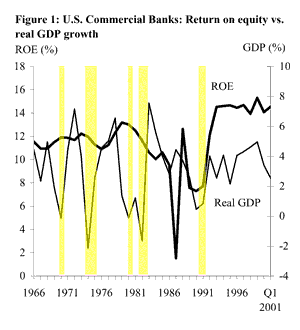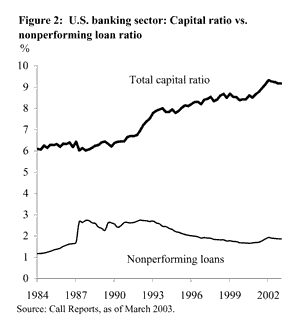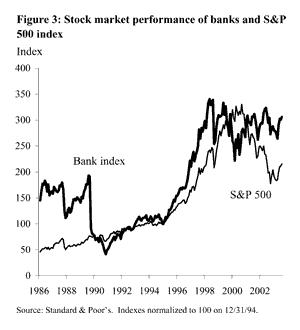During the 2001 recession and the recovery, bank performance has been remarkably strong. To be sure, banks tightened their lending standards as the economy softened, lessening their exposures to problem areas such as the technology and telecommunications sectors.
- Bank performance and condition
- Changes in bank regulation
- Changes in bank supervision
- Conclusion
- References
During the 2001 recession and the recovery, bank performance has been remarkably strong. To be sure, banks tightened their lending standards as the economy softened, lessening their exposures to problem areas such as the technology and telecommunications sectors. But it is also notable that banks’ lending strategies during the late 1990s boom never resulted in a buildup of loan losses once the economy weakened, as has happened so often in the past.
There are a number of possible reasons for the banking sector’s resilience. In fact, we cannot rule out simple good fortune. Perhaps the 2001 recession was different from previous recessions in that it did not have a great impact on the sectors the banks had exposure to. Indeed, the technology firms hardest hit by the recession are relatively less dependent on banks for external finance than firms in other sectors. It may also be that banking has changed over time, and that these changes have had an impact on the cyclicality of banking. Today’s large bank has more capital, derives relatively more of its income from nonlending sources, contains a different mix of loans in the loan portfolio, and is much better able to hedge its financial risks than it was in the past. These changes could have resulted in better performance during this downturn. Finally, the 1990s were notable for changes in regulation. Much of this change was in reaction to the banking crisis of the late 1980s. Thus, it could be that the supervision has changed and that the 2001 recession should be viewed as the first real test of the efficacy of these changes. In this Economic Letter we will investigate these possibilities, focusing particularly on the changes in regulation and supervision.
Bank performance and condition



The clearest indication of the banking sector’s resilience in the most recent downturn can be seen in the aggregate performance measures. Aggregate return on equity (Figure 1) has remained remarkably stable throughout the late 1990s following the recovery from the banking crisis. The figure also shows that it is relatively unusual to see steep contemporaneous declines in bank performance as the economy enters into recession. In this regard, bank performance during the 1990-1991 recession was quite different from that in previous downturns.
Bank conditions, as measured by the book equity capital ratio and the nonperforming loan ratio, also illustrate that the banking sector was well-positioned for the most recent recession (see Figure 2). Simply put, the banking sector today is better capitalized now than it was in the early 1990s. This is particularly clear when one looks at the total capital ratio.
The banking sector has changed in distinct ways over our sample period: the number of banks has shrunk through consolidation and failure, banks have substituted commercial and industrial lending for real estate lending, and banks have gradually expanded their business lines to reduce their reliance on interest income from lending. Perhaps more importantly, the improvements in risk management offered by securitization, loan syndication, and hedging via derivatives instruments have helped banks shed unwanted risks.
These developments in the banking sector all coincide with higher stock market capitalization rates for banks and lower stock return volatility. Indeed, bank stocks have outperformed the market since 1995, and particularly during the 2001 recession (see Figure 3); evidently, investors viewed banks as better positioned than the overall market to flourish in the slowing economy.
Certain changes in bank regulation during the 1990s led to changes in bank behavior, and we highlight three of the most significant initiatives. Two regulatory initiatives focused on the amount of capital held by banks. The first, the Basel Capital Accord of 1988, standardized capital requirements for internationally active banks at 8% of risk-weighted assets. While the capital standards in the first Accord did not apply to the vast majority of U.S. banks, the change in regulatory environment did spill over to domestic bank regulators, putting new emphasis on risk and the varying capital needed to support portfolios with different exposures.
Capital regulation took on further prominence with the passage of the FDIC Improvement Act (FDICIA) of 1991, which laid out a list of privileges, or eligible operations, for banks deemed to be well-capitalized. If a bank held at least 8% total equity capital, it could engage in operations such as merger and acquisition activity and securities underwriting, and it would be eligible for insurance for its brokered deposits. Linked to FDICIA was the new mandate of prompt corrective action, which required regulators to shut down any bank with capital ratio below 2%. The key features of FDICIA were to reduce the scope for moral hazard at the banks by requiring them to hold more capital and to provide greater incentives to protect that capital.
Both regulatory changes had a clear impact on the capital U.S. banks held. For example, Furlong (1992) shows that the average target capital ratios for all banks rose from about 7% during the 1985-1989 period to almost 9% during the 1990-1991 period. This increase was observed for both large banks, which were more likely to be affected by these regulatory changes, and for small banks. All of the reported increases were found to be statistically significant.
The third regulatory initiative was the passage of the Riegle-Neal Act of 1994, which paved the way for interstate banking. By 1998, most states had implemented its provisions. The overall effect of Riegle-Neal was to provide for the potential of cross-state diversification, which, in theory, could reduce the variance of bank condition variables, such as nonperforming loans. The wave of ensuing cross-state mergers in the banking industry certainly suggest that banks believed there was diversification potential.
The prudential oversight of the banking system includes both regulations and ongoing supervision. The major regulatory changes discussed above had a major impact on the banking industry and changed important tenets of banking in the U.S. It is reasonable to assume that such changes also led to modifications in the supervisory process and in supervisory concerns. We can gain an insight into some of these potential changes by looking at supervisory bank ratings. These ratings, like the agency ratings, are based on an absolute scale and are intended to be comparable over time. Interestingly, research has shown that both agency and supervisory rating standards may actually change over time. Blume, Lim, and MacKinlay (1998) were among the first to report this for the case of the ratings agencies. They observed that the apparent worsening of U.S. credit quality in the 1990s was not so much a deterioration in corporate balance sheets as it was a change in behavior by the ratings agencies. In essence, the authors estimated a simple model of ratings using data from a given year, extracted a set of ratings agency standards from the model, and then applied those estimated standards to data generated in a later year. They concluded that lower debt ratings in later years were driven in part by tougher standards.
Studies of this sort have been conducted on the bank supervisory ratings as well. Berger, Kyle, and Scalise (2001) suggest that commercial bank rating standards were “tougher” during the credit crunch of the early 1990s, and then eased in the expansion. In our own empirical research, we model supervisory ratings for bank holding companies (BHCs) during the 1990s. We relate a BHC’s supervisory rating to variables such as the BHC’s lagged nonperforming loan ratio, its loan loss reserve ratio, the capital ratio, return on assets, and its lagged rating. Our results for the early 1990s match those of Berger, Kyle, and Scalise; moreover, we find that standards changed again in the late 1990s and early 2000. Specifically, the actual ratings assigned in the latter period were more strict than predicted by a model based on empirical ratings standards from the mid-1990s.
It is important to note that all of these studies are model-based approaches, so they cannot include the complete list of variables that supervisors use to rate banks. However, empirical results suggesting that supervisory standards can change imply that specific banking outcomes—such as finding that a bank’s nonperforming loan ratio is, say, 2%—have differing impacts on supervisory ratings at different points in time. This is consistent with the notion that supervisors adjusted to the new economic and regulatory environment during the 1990s.
Banking has been thought to be a cyclical business, yet banks have actually enjoyed excellent performance and health throughout the last cycle. In this Economic Letter we have investigated some of the reasons for this good performance. While we cannot rule out the explanation that the 1990s and the 2001 recession were relatively tranquil economic times with no shocks large enough to destabilize the banking sector, we argue that the good performance is at least in part due to changes in regulation and changes in approach by supervisory staff.
John Krainer
Economist
Jose A. Lopez
Senior Economist
References
Berger, A., M. Kyle, and J. Scalise. 2001. “Did U.S. Bank Supervisors Get Tougher during the Credit Crunch? Did They Get Easier during the Banking Boom? Did It Matter to Bank Lending?” In Prudential Supervision: What Works and What Doesn’t, ed. Frederic S. Mishkin. Chicago: University of Chicago Press.
Blume, M., F. Lim, and A. MacKinlay. 1998. “The Declining Credit Quality of U.S. Corporate Debt: Myth or Reality.” Journal of Finance 53, pp. 1,389-1,413.
Furlong, F. 1992. “Capital Regulation and Bank Lending.” FRBSF Economic Review 3, pp. 23-33.
Opinions expressed in FRBSF Economic Letter do not necessarily reflect the views of the management of the Federal Reserve Bank of San Francisco or of the Board of Governors of the Federal Reserve System. This publication is edited by Anita Todd and Karen Barnes. Permission to reprint portions of articles or whole articles must be obtained in writing. Please send editorial comments and requests for reprint permission to research.library@sf.frb.org